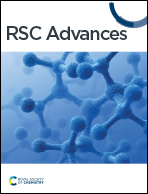De novo creation of fluorescent molecules via adversarial generative modeling
Abstract
The development of AI for fluorescent materials design is technologically demanding due to the issue of accurately forecasting fluorescent properties. Besides the huge efforts made in predicting the photoluminescent properties of organic dyes in terms of machine learning techniques, this article aims to introduce an adversarial generation paradigm for the rational design of fluorescent molecules. Molecular SMILES is employed as the input of a GRU based autoencoder, where the encoding and decoding of the string information are processed. A generative adversarial network is applied on the latent space with a generator to generate samples to mimic the latent space, and a discriminator to distinguish samples from the latent space. It is found that the excited state property distributions of generated molecules fully match those of the original samples, with the molecular synthesizability being accessible as well. Further screening of the generated samples delivers a remarkable luminescence efficiency of molecules epitomized by the significant oscillator strength and charge transfer characteristics, demonstrating the great potential of the adversarial model in enriching the fluorescent library.



 Please wait while we load your content...
Please wait while we load your content...